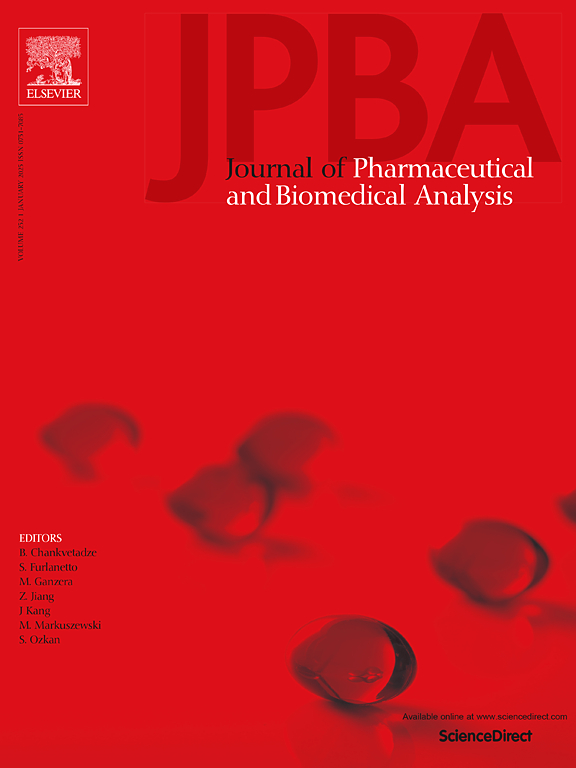Serum metabolic signatures and MetalnFF diagnostic score for mild and moderate metabolic dysfunction-associated steatotic liver disease
IF 3.1
3区 医学
Q2 CHEMISTRY, ANALYTICAL
Journal of pharmaceutical and biomedical analysis
Pub Date : 2025-02-25
DOI:10.1016/j.jpba.2025.116772
引用次数: 0
Abstract
To explore serum metabolic changes in metabolic dysfunction-associated steatotic liver disease (MASLD) with mild or moderate steatosis and develop a diagnostic index based on liver fat content to differentiate these stages. A total of 149 participants were enrolled from the Nutrition Health Atlas Project in 2019 (Stage 1, n = 92) and 2022 (Stage 2, n = 57). Serum levels of amino acids, free fatty acids (FFAs) and other organic acids were quantified using liquid or gas chromatography-mass spectrometry. The relationships between serum metabolites and magnetic resonance imaging proton density hepatic fat fraction were analyzed and a predictive model fitting fat fraction was constructed in Stage 1 and validated in Stage 2. Patients with moderate MASLD had significantly higher pyruvic acid, 2-ketoglutaric acid, malic acid, 2-hydroxyisocaproic acid and FFA(C14:0) than mild MASLD. Pathway analysis indicated that liver fat accumulation is associated with alterations in amino acid, FFA metabolism and tricarboxylic acid cycle (TCA). The MetalnFF score was developed to discriminate among three groups, achieving an area under the curve (AUC) of 0.956 (95 %CI:0.905, 1.00) for MASLD and 0.857 (95 %CI:0.745, 0.968) for moderate MASLD in Stage 1, and was further validated in Stage 2 with an AUC of 0.986 (95 %CI: 0.951, 1.00) and 0.759 (95 %CI:0.607, 0.921), respectively. In the early stages of MASLD, disrupted amino acid, FFAs metabolism and TCA cycle have occurred. As the disease progresses, metabolic disturbances in pyruvate metabolism become more severe. These findings enhance a deeper understanding of pathogenesis and propose MetalnFF score as a potential diagnostic tool.
求助全文
约1分钟内获得全文
求助全文
来源期刊
CiteScore
6.70
自引率
5.90%
发文量
588
审稿时长
37 days
期刊介绍:
This journal is an international medium directed towards the needs of academic, clinical, government and industrial analysis by publishing original research reports and critical reviews on pharmaceutical and biomedical analysis. It covers the interdisciplinary aspects of analysis in the pharmaceutical, biomedical and clinical sciences, including developments in analytical methodology, instrumentation, computation and interpretation. Submissions on novel applications focusing on drug purity and stability studies, pharmacokinetics, therapeutic monitoring, metabolic profiling; drug-related aspects of analytical biochemistry and forensic toxicology; quality assurance in the pharmaceutical industry are also welcome.
Studies from areas of well established and poorly selective methods, such as UV-VIS spectrophotometry (including derivative and multi-wavelength measurements), basic electroanalytical (potentiometric, polarographic and voltammetric) methods, fluorimetry, flow-injection analysis, etc. are accepted for publication in exceptional cases only, if a unique and substantial advantage over presently known systems is demonstrated. The same applies to the assay of simple drug formulations by any kind of methods and the determination of drugs in biological samples based merely on spiked samples. Drug purity/stability studies should contain information on the structure elucidation of the impurities/degradants.

 求助内容:
求助内容: 应助结果提醒方式:
应助结果提醒方式:


